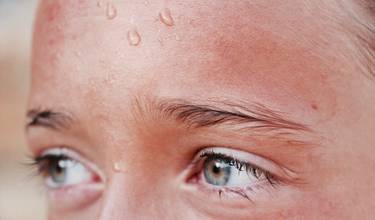At least 1% of the British population suffer from hyperhidrosis, which is characterised by unusually large sweat production. When you suffer from hyperhidrosis, you sweat even if you are not physically active or have another natural explanation for the additional sweat production (e.g. if you are emotionally affected).
However, there are various ways of treating hyperhidrosis. These include:
- Antiperspirants with aluminum chloride:Antiperspirants contain aluminum salts. These work by reacting with proteins in the sweat gland duct. This creates a barrier preventing the sweat from reaching the surface of the skin. Antiperspirants are available in varieties that can be purchased without a prescription, e.g. as: creams, roll-ons, pumps, sticks and sprays. Some types of deodorants also contain aluminum salts in addition to perfumes and can therefore act as an antiperspirant to some degree. However, it is also possible to buy antiperspirants that only contain aluminum salts and not perfume. Treatment with antiperspirants must be repeated regularly as it only temporarily closes the sweat ducts.
- Botox:Botulinum injections help restrict the nerves in signaling to the sweat glands that they should produce sweat, which contributes to restricting sweat production. This treatment should only be done one to four times a year depending on how effective the treatment is for the individual. The Botox treatment is done either at a private clinic, where you have to pay for the treatment yourself, or through the public health system if you are referred by a doctor.
- Iontophoresis:Iontophoresis uses a weak current that lead ions into the sweat gland ducts. This creates a barrier preventing the sweat from reaching the surface of the skin. Iontophoresis should be repeated three to four times a week for 20-30 minutes at a time at the beginning of treatment. Iontophoresis treatment is done by a dermatologist. It therefore requires a referral from a doctor to be treated with iontophoresis. In collaboration with the dermatologist, the treatment can be relocated to be done at home, as it is very time consuming. There are home appliances that can be used for the treatment once it has begun.
- Anticholinergics:Anticholinergics affect the nerves that send signals to the sweat glands. However, there are many side effects of this type of medicine, which is consumed orally. Treatment with anticholinergic drugs is prescribed by a doctor and is thus subject to prescription.
- Axillary emptying:This type of treatment removes the sweat glands in the armpits. This can be done either by scraping, vacuum suction (as known from liposuction) or by using non-invasive methods such as e.g. micro waves. Since the treatment requires an operation, you must be referred by a doctor if this is to be done within the public hospital services. Then again, it is also possible to have the operation performed at a private clinic, which does not require a referral - however, this requires self-payment.
A study conducted in 2016 compared Botox treatment with axillary emptying using vacuum suction and micro waves. It showed that all three types of treatment were effective and safe, but that treatments with micro waves and Botox were better in the short term, when comparing these methods with the treatment using vacuum suction. However, more studies are needed before it is possible to compare the effectiveness of these methods, which can help improve the lives of people with hyperhidrosis.








